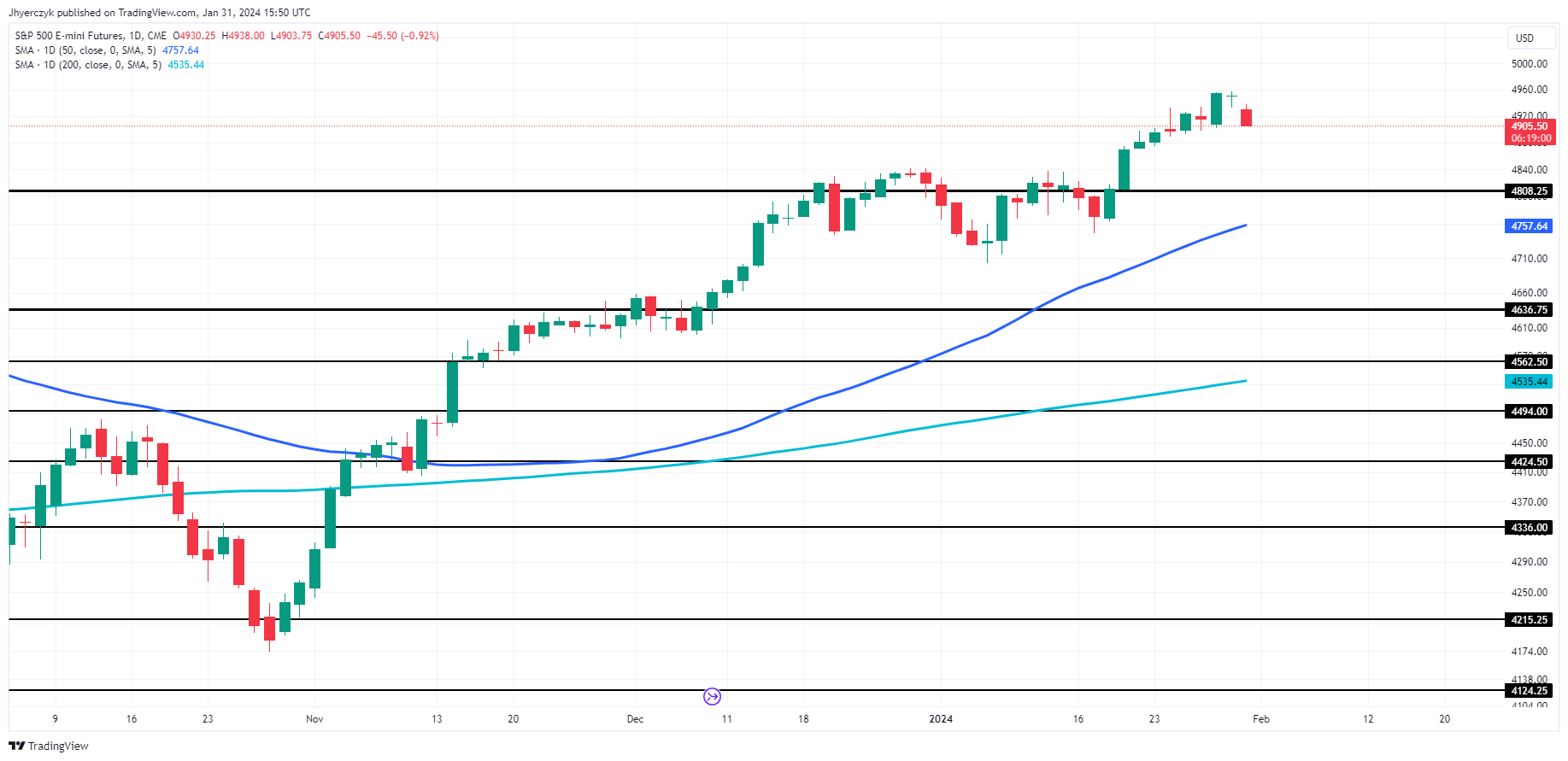Nasdaq Index, Dow Jones, S&P 500 News: Investors Brace for Impact of Fed’s Policy Call
Key Points
- Anticipation Builds for Upcoming Fed Decision
- Alphabet’s Earnings Performance Adds Pre-Fed Uncertainty
- Walmart’s Stock Split: A Strategic Decision Amid Fed Waiting Game
Short-Term Market Forecast Post-Fed Decision
As investors eagerly await the Federal Reserve’s policy statement and interest rate decision, the U.S. stock market is sorting through mixed performances in various sectors. The tech-heavy Nasdaq Composite and the S&P 500 Index face selling pressure, primarily due to Alphabet’s significant decline, while the Dow Jones Industrial Average edges higher, buoyed by Walmart’s 3-for-1 stock split announcement.
At 15:39 GMT, the Dow Jones Industrial Average is trading 38479.32, up 12.01 or +0.03%. The S&P 500 Index is at 4880.19, down 44.48 or -0.90% and the Nasdaq-100 is trading 15261.73, down 248.17 or -1.61%.
Post-Fed Market Expectations
The fate of the market hinges on the Federal Reserve’s actions and communications. If the central bank adheres to the widely anticipated decision to leave interest rates unchanged, we can expect initial relief in the markets. However, the real focus will be on the language used in the post-meeting statement and Jerome Powell’s remarks.
Should the Fed adopt a “later and fewer” approach to rate cuts, as suggested by experts, we might see a market response that reflects confidence in the central bank’s measured approach. Investors may interpret this as a signal that the Fed is cautious about overreacting to economic concerns.
Conversely, any surprises or hawkish undertones in the Fed’s communication could lead to increased volatility and potential downward pressure on the markets. Traders will scrutinize Powell’s words for hints of the central bank’s future policy direction and its stance on addressing economic challenges.
Tech Sector Resilience and Challenges
While the technology sector, a significant driver of the recent market rally, faces valuation concerns, it remains a focal point for traders. Alphabet’s decline, despite strong earnings, raises questions about the sector’s short-term performance. Investors will closely watch how tech companies respond to these challenges and whether they can deliver the earnings growth needed to support their high valuations.
In the coming days, market participants will gauge whether Alphabet’s decline was a short-term profit-taking trend or a signal of broader sentiment. The ability of tech companies to justify their elevated price-to-book levels will be crucial in determining the sector’s direction.
Stock-Specific Opportunities and Risks
Specific stocks such as Boeing, which reported earnings and saw a rise despite a lack of 2024 guidance due to a previous incident, and Paramount Global, with a significant surge following a takeover offer, offer unique opportunities.
Conversely, Advanced Micro Devices (AMD) and Mondelez International face challenges, with AMD’s softer-than-expected first-quarter forecast and Mondelez’s growth slowdown and muted sales expectations for 2024.
Additionally, Walmart’s 3-for-1 stock split announcement has the potential to drive increased interest in the retail giant’s shares.
Short-Term Outlook
In conclusion, the market’s short-term direction post-Fed decision will depend on the central bank’s actions and the tone of its communication. Tech sector resilience and individual stock performances will play a pivotal role in shaping market sentiment. Investors should remain vigilant, monitor the Fed’s remarks closely, and be prepared for potential market shifts in the days ahead, especially after Friday’s Non-Farm Payrolls report.
Technical Analysis

The E-mini S&P 500 Index is trading sharply lower on Wednesday after hitting a record high the previous session.
Although the main trend is up, the market, currently trading 4905.75, remains susceptible to a near-term correction due to its wide relationship to the 50-day moving average at 4757.61.
The question is, will investors continue to chase technology stocks higher in the hopes that earnings will eventually “catch up?” Or will investors finally wake up and take a little off the table and wait for more favorable prices? That is enough to fuel heightened volatility.